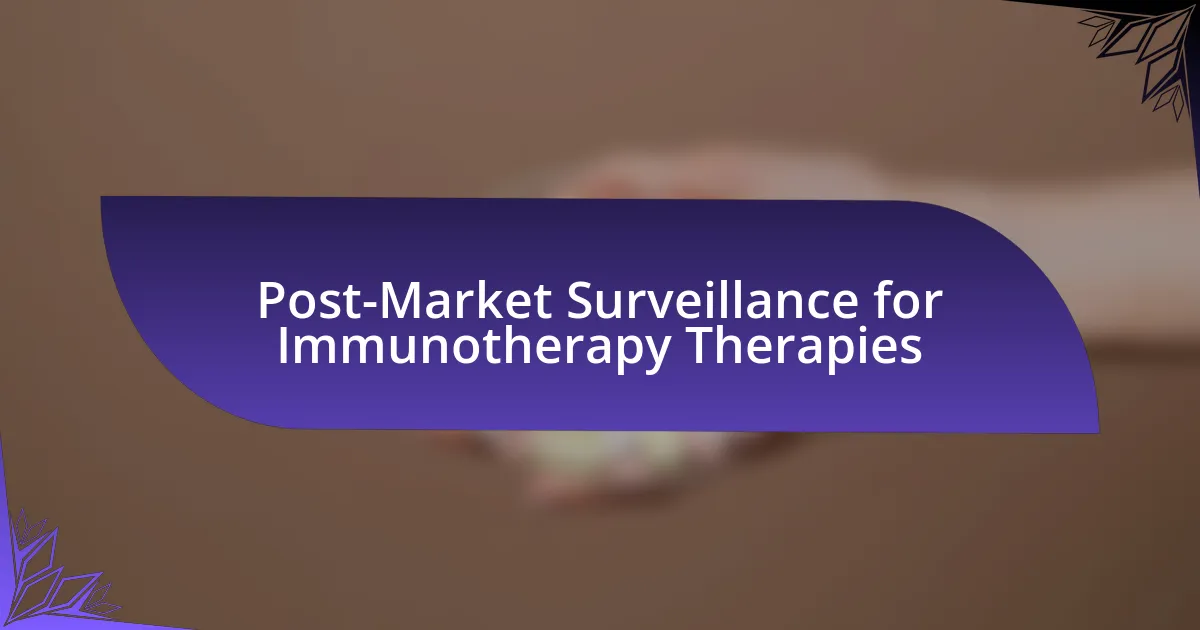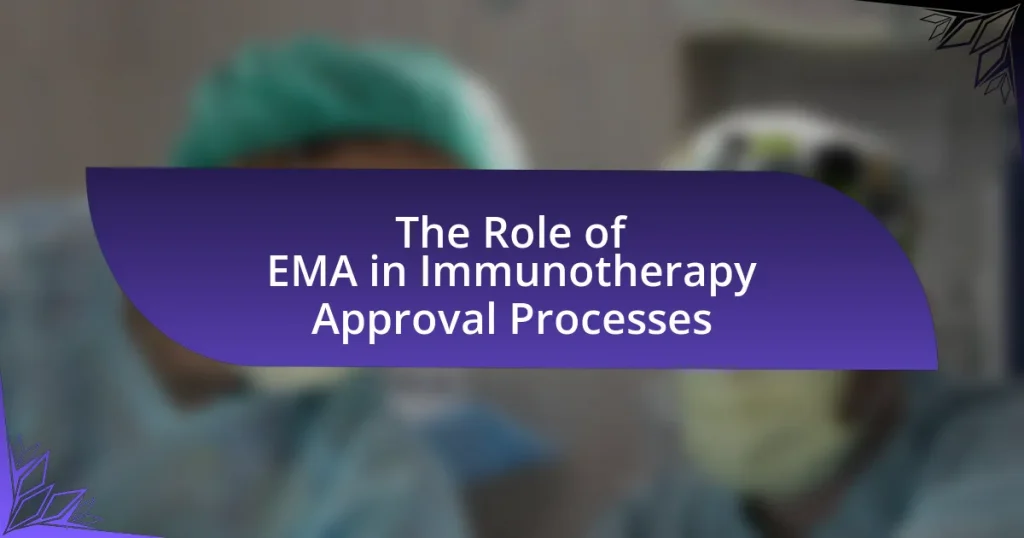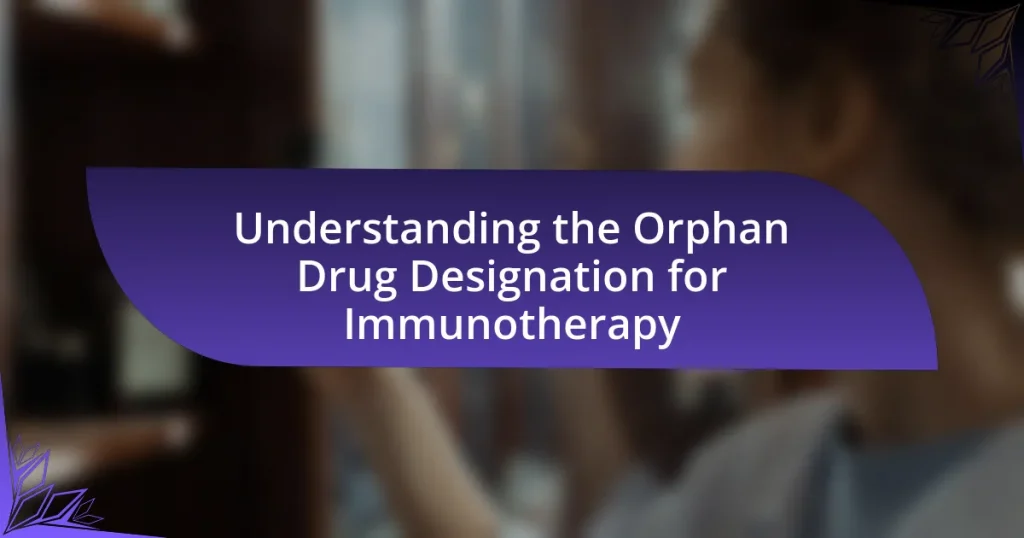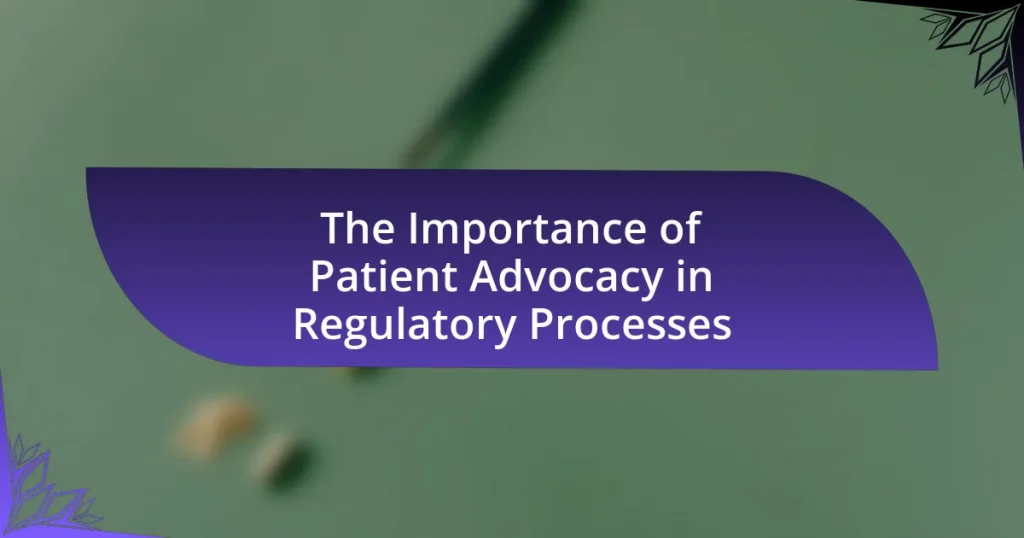Post-market surveillance for immunotherapy therapies is a critical process that involves the systematic monitoring of the safety and effectiveness of these treatments after they have been approved for public use. This article outlines the importance of post-market surveillance in identifying adverse effects and long-term outcomes that may not have been evident during clinical trials. It discusses the regulatory requirements set by agencies such as the FDA and EMA, the methodologies employed for data collection and analysis, and the challenges faced in ensuring effective surveillance. Additionally, the article highlights the role of adverse event reporting systems, the impact of surveillance on patient safety, and future trends in technology and data analytics that aim to enhance post-market monitoring efforts.
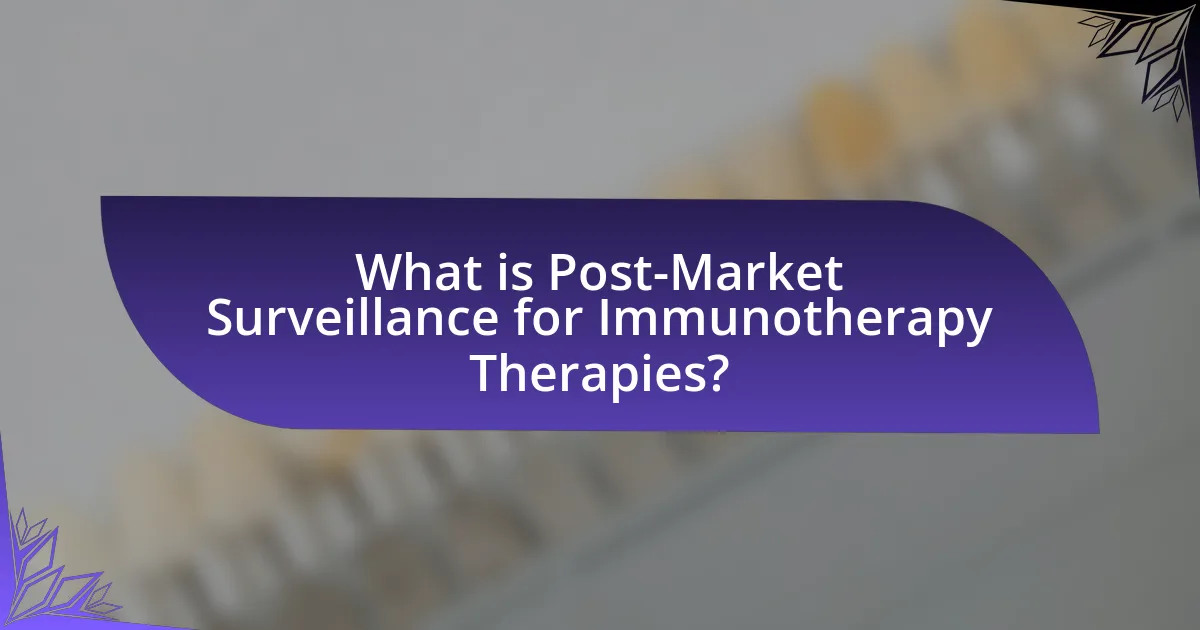
What is Post-Market Surveillance for Immunotherapy Therapies?
Post-market surveillance for immunotherapy therapies refers to the systematic monitoring of the safety and effectiveness of these treatments after they have been approved for public use. This process is essential to identify any adverse effects or long-term outcomes that may not have been evident during clinical trials. Regulatory agencies, such as the FDA, require ongoing data collection and analysis to ensure that the benefits of immunotherapy therapies continue to outweigh any risks, thereby safeguarding patient health and informing future treatment protocols.
Why is Post-Market Surveillance important for Immunotherapy Therapies?
Post-market surveillance is crucial for immunotherapy therapies because it ensures ongoing safety and efficacy monitoring after a treatment is approved for public use. This process helps identify rare or long-term adverse effects that may not have been evident during clinical trials, which typically involve a limited number of participants and a shorter duration. For instance, the FDA mandates post-marketing studies for certain immunotherapies to gather real-world data on their performance and safety profiles, thereby enhancing patient safety and informing future treatment guidelines.
What are the key objectives of Post-Market Surveillance?
The key objectives of Post-Market Surveillance (PMS) are to monitor the safety and effectiveness of medical products after they have been approved for market use. PMS aims to identify any adverse events or long-term effects that may not have been evident during clinical trials, ensuring ongoing patient safety. Additionally, PMS facilitates the collection of real-world data to assess the product’s performance in diverse populations and conditions, which is crucial for making informed regulatory decisions. According to the FDA, effective PMS can lead to timely updates in product labeling and the implementation of risk mitigation strategies, thereby enhancing overall public health outcomes.
How does Post-Market Surveillance differ from pre-market evaluation?
Post-Market Surveillance differs from pre-market evaluation in that it focuses on monitoring the safety and effectiveness of a product after it has been approved and is available to the public, while pre-market evaluation assesses the product’s safety and efficacy before it reaches the market. Post-Market Surveillance involves ongoing data collection and analysis to identify any adverse effects or long-term outcomes associated with the product, as evidenced by regulatory requirements that mandate continuous reporting of adverse events. In contrast, pre-market evaluation relies on clinical trial data to determine whether the product meets safety and efficacy standards prior to approval, which is supported by the rigorous testing protocols established by regulatory agencies like the FDA.
What are the regulatory requirements for Post-Market Surveillance?
Regulatory requirements for Post-Market Surveillance (PMS) mandate that manufacturers continuously monitor the safety and effectiveness of their products after they have been approved for market use. These requirements are outlined by regulatory bodies such as the U.S. Food and Drug Administration (FDA) and the European Medicines Agency (EMA), which stipulate that companies must collect and analyze data on adverse events, conduct periodic safety updates, and implement risk management plans. For instance, the FDA requires manufacturers to submit annual reports detailing any new safety information and to maintain a system for reporting adverse events, as specified in the FDA’s guidance on post-market safety reporting.
Which agencies oversee Post-Market Surveillance for Immunotherapy Therapies?
The agencies that oversee Post-Market Surveillance for Immunotherapy Therapies include the U.S. Food and Drug Administration (FDA) and the European Medicines Agency (EMA). The FDA is responsible for monitoring the safety and effectiveness of immunotherapy products in the United States, while the EMA performs similar functions for the European Union. Both agencies utilize adverse event reporting systems and post-marketing studies to ensure ongoing safety assessments of these therapies.
What guidelines must be followed during Post-Market Surveillance?
During Post-Market Surveillance for immunotherapy therapies, guidelines include continuous monitoring of product safety and effectiveness, reporting adverse events, and conducting periodic safety updates. Regulatory bodies, such as the FDA and EMA, require manufacturers to collect and analyze data on the long-term effects of therapies, ensuring compliance with established safety standards. Additionally, manufacturers must engage in risk management activities and maintain transparent communication with healthcare professionals and patients regarding any emerging safety information. These guidelines are essential for ensuring ongoing patient safety and therapeutic efficacy in the market.
What methodologies are used in Post-Market Surveillance?
Post-market surveillance methodologies include active surveillance, passive surveillance, and signal detection. Active surveillance involves systematic data collection from healthcare providers and patients to monitor the safety and effectiveness of immunotherapy therapies. Passive surveillance relies on voluntary reporting of adverse events by healthcare professionals and patients, which can lead to underreporting. Signal detection utilizes statistical methods to identify potential safety issues from large datasets, such as electronic health records or registries. These methodologies are essential for ensuring ongoing safety and efficacy of immunotherapy therapies after they have been approved for market use.
How are data collection and analysis conducted in Post-Market Surveillance?
Data collection and analysis in Post-Market Surveillance are conducted through systematic monitoring of adverse events, patient outcomes, and product performance after a therapy is approved for market use. This process typically involves gathering data from various sources, including healthcare providers, patients, and electronic health records, to identify any safety concerns or efficacy issues related to immunotherapy therapies. Regulatory bodies, such as the FDA, require manufacturers to report adverse events and conduct periodic safety reviews, ensuring that the collected data is analyzed for trends and potential risks. For instance, a study published in the Journal of Clinical Oncology highlighted the importance of real-world evidence in assessing the long-term safety of immunotherapy, demonstrating that ongoing data collection is crucial for informed decision-making in patient care.
What role do adverse event reporting systems play in Post-Market Surveillance?
Adverse event reporting systems are crucial for Post-Market Surveillance as they facilitate the collection and analysis of safety data related to immunotherapy therapies after they have been approved for public use. These systems enable healthcare professionals and patients to report adverse events, which are then systematically reviewed to identify potential safety signals and trends. For instance, the FDA’s Adverse Event Reporting System (FAERS) collects data that can lead to further investigation and regulatory actions, such as label changes or product recalls, ensuring ongoing patient safety. This proactive monitoring helps to mitigate risks associated with immunotherapy therapies and enhances the overall understanding of their safety profiles in diverse populations.
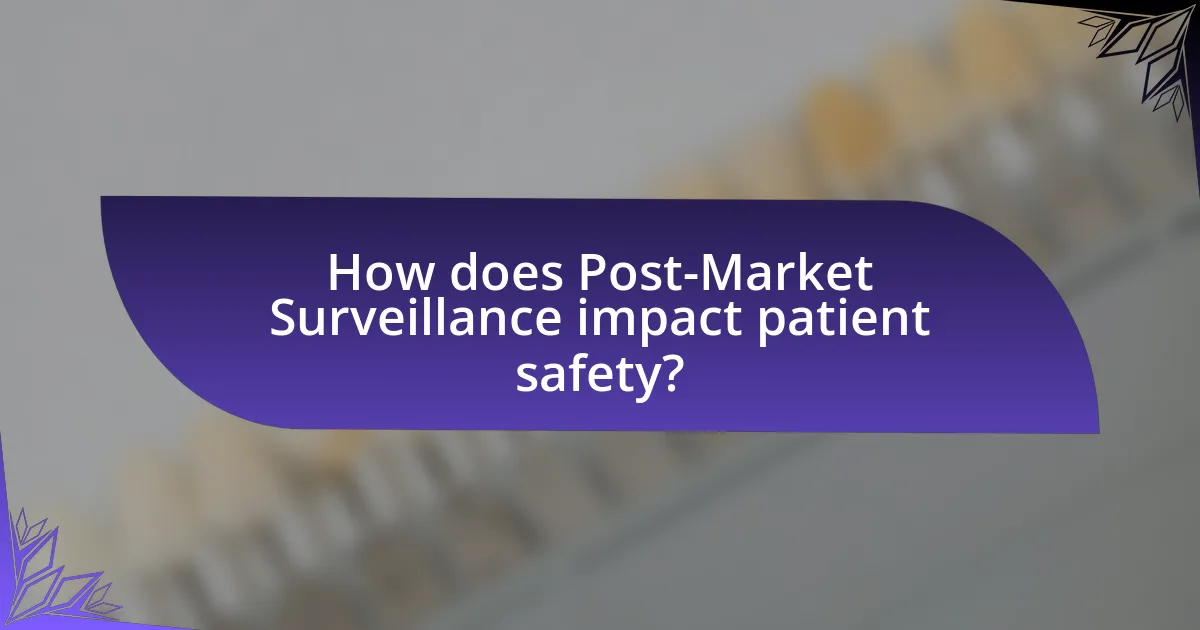
How does Post-Market Surveillance impact patient safety?
Post-market surveillance significantly enhances patient safety by systematically monitoring the performance and adverse effects of immunotherapy therapies after they have been approved for use. This ongoing evaluation allows for the identification of rare or long-term side effects that may not have been evident during clinical trials, thereby ensuring that any emerging safety concerns are promptly addressed. For instance, the FDA’s Sentinel Initiative utilizes real-world data to track the safety of medical products, which has led to timely updates in safety information and labeling changes for various therapies. Such proactive measures contribute to minimizing risks and improving patient outcomes in the long term.
What are the potential risks associated with Immunotherapy Therapies?
Immunotherapy therapies carry potential risks including immune-related adverse events, infusion reactions, and long-term effects. Immune-related adverse events occur when the immune system attacks healthy tissues, leading to conditions such as colitis, dermatitis, and pneumonitis. Infusion reactions can manifest as fever, chills, or hypotension during treatment. Long-term effects may include the development of autoimmune disorders or secondary malignancies, as evidenced by studies indicating that approximately 30% of patients experience immune-related adverse events, with some requiring corticosteroid treatment to manage symptoms.
How can Post-Market Surveillance mitigate these risks?
Post-Market Surveillance can mitigate risks associated with immunotherapy therapies by continuously monitoring the safety and effectiveness of these treatments after they have been approved for public use. This ongoing assessment allows for the identification of adverse events, unexpected side effects, and long-term outcomes that may not have been evident during clinical trials. For instance, the FDA’s Sentinel Initiative utilizes electronic health data to track the safety of approved therapies, enabling timely interventions when safety concerns arise. By analyzing real-world data, Post-Market Surveillance helps ensure that any emerging risks are promptly addressed, thereby enhancing patient safety and treatment efficacy.
What are the consequences of inadequate Post-Market Surveillance?
Inadequate Post-Market Surveillance can lead to severe consequences, including undetected safety issues and adverse events associated with immunotherapy therapies. When surveillance is insufficient, harmful side effects may not be reported or addressed, resulting in patient harm and loss of trust in medical products. Historical data shows that inadequate monitoring has previously led to recalls and legal actions against manufacturers, highlighting the critical need for effective surveillance systems to ensure ongoing safety and efficacy. For instance, the withdrawal of certain drugs from the market due to unforeseen complications underscores the importance of robust post-market monitoring to protect public health.
How does Post-Market Surveillance contribute to product improvement?
Post-Market Surveillance (PMS) contributes to product improvement by systematically collecting and analyzing data on the safety and effectiveness of immunotherapy therapies after they have been approved for market use. This ongoing evaluation allows manufacturers and regulatory bodies to identify potential adverse effects, efficacy issues, and areas for enhancement based on real-world patient experiences. For instance, studies have shown that PMS can lead to modifications in treatment protocols, labeling changes, or even product recalls when safety concerns arise, thereby ensuring that therapies remain effective and safe for patients.
What feedback mechanisms are in place for continuous improvement?
Feedback mechanisms for continuous improvement in post-market surveillance for immunotherapy therapies include regular data collection from healthcare providers, patient feedback systems, and adverse event reporting. These mechanisms ensure that real-world efficacy and safety data are systematically gathered and analyzed. For instance, the FDA mandates that manufacturers report adverse events, which helps identify potential safety issues and informs necessary adjustments in treatment protocols. Additionally, patient registries and surveys provide insights into treatment outcomes and patient experiences, facilitating ongoing enhancements in therapy effectiveness and safety.
How can data from Post-Market Surveillance inform future research and development?
Data from Post-Market Surveillance can inform future research and development by identifying safety signals and efficacy trends that emerge after a product’s release. This surveillance provides real-world evidence on how immunotherapy therapies perform in diverse patient populations, revealing potential adverse effects or unexpected benefits that were not evident in pre-market trials. For instance, the FDA’s Sentinel Initiative utilizes post-market data to monitor the safety of medical products, allowing researchers to adjust clinical practices and guide the development of new therapies based on observed outcomes. By analyzing this data, developers can refine existing treatments and innovate new solutions that better meet patient needs, ultimately enhancing therapeutic effectiveness and safety profiles.
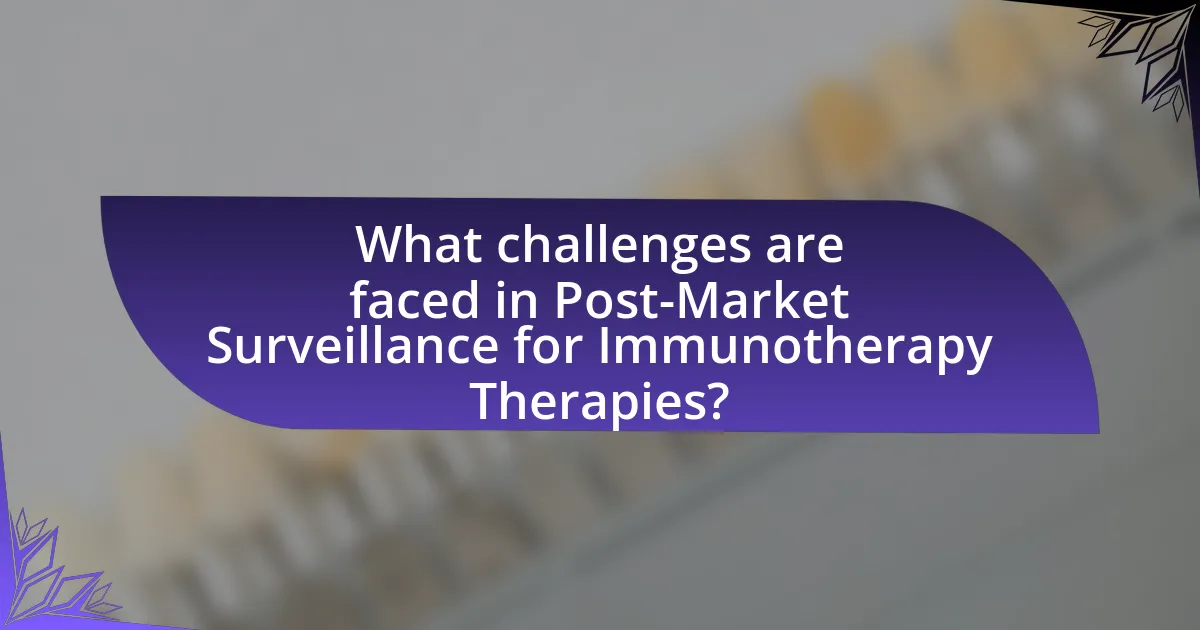
What challenges are faced in Post-Market Surveillance for Immunotherapy Therapies?
Post-market surveillance for immunotherapy therapies faces several challenges, including the complexity of immune responses, variability in patient populations, and the long-term nature of adverse effects. The immune system’s diverse reactions can lead to unpredictable safety profiles, making it difficult to identify and assess risks effectively. Additionally, the heterogeneity among patients, such as differences in genetics, comorbidities, and concurrent medications, complicates data interpretation. Long-term monitoring is essential, as some adverse effects may not manifest until years after treatment, necessitating robust and ongoing data collection methods to ensure patient safety and efficacy of therapies.
What are the common obstacles in data collection and reporting?
Common obstacles in data collection and reporting include data quality issues, lack of standardization, and resource constraints. Data quality issues arise from incomplete or inaccurate information, which can lead to unreliable results. Lack of standardization in data formats and collection methods complicates the aggregation and comparison of data across different sources. Resource constraints, such as limited funding and personnel, hinder the ability to collect and analyze data effectively. These obstacles can significantly impact the effectiveness of post-market surveillance for immunotherapy therapies, as highlighted in studies that emphasize the importance of robust data collection frameworks to ensure patient safety and treatment efficacy.
How do variations in regulatory environments affect Post-Market Surveillance?
Variations in regulatory environments significantly impact Post-Market Surveillance (PMS) by influencing the requirements for data collection, reporting timelines, and the scope of monitoring activities. For instance, in the European Union, the Medical Device Regulation mandates extensive PMS plans that require continuous data collection and risk assessment, while in the United States, the FDA may allow more flexible approaches, focusing on adverse event reporting and periodic safety updates. This divergence can lead to differences in the thoroughness and frequency of surveillance activities, ultimately affecting the safety and efficacy monitoring of immunotherapy therapies. The effectiveness of PMS is contingent upon these regulatory frameworks, as they dictate the resources allocated for surveillance and the methodologies employed, which can vary widely across jurisdictions.
What strategies can be employed to overcome these challenges?
To overcome challenges in post-market surveillance for immunotherapy therapies, implementing robust data collection and analysis systems is essential. These systems should integrate real-world evidence from diverse sources, such as electronic health records and patient registries, to monitor safety and efficacy effectively. For instance, the FDA’s Sentinel Initiative demonstrates how large-scale data can be utilized to identify adverse events and assess long-term outcomes in patients receiving immunotherapy. Additionally, fostering collaboration among stakeholders, including regulatory bodies, healthcare providers, and patients, enhances transparency and facilitates timely reporting of safety concerns. This collaborative approach is supported by the European Medicines Agency’s guidelines, which emphasize the importance of stakeholder engagement in pharmacovigilance activities.
What best practices should be followed in Post-Market Surveillance?
Best practices in Post-Market Surveillance for immunotherapy therapies include continuous monitoring of adverse events, systematic collection of real-world data, and regular risk-benefit assessments. Continuous monitoring ensures that any unexpected side effects or complications are promptly identified and addressed, which is critical given the unique safety profiles of immunotherapies. Systematic collection of real-world data, such as patient outcomes and treatment effectiveness, allows for a comprehensive understanding of the therapy’s performance outside clinical trials. Regular risk-benefit assessments help in evaluating the ongoing safety and efficacy of the therapy, ensuring that it remains beneficial for patients. These practices are essential for maintaining patient safety and optimizing therapeutic outcomes in the evolving landscape of immunotherapy.
How can stakeholders ensure compliance with regulatory requirements?
Stakeholders can ensure compliance with regulatory requirements by implementing robust monitoring and reporting systems that align with established guidelines. These systems should include regular audits, risk assessments, and adherence to protocols set by regulatory bodies such as the FDA or EMA. For instance, the FDA mandates that manufacturers of immunotherapy therapies conduct post-market surveillance to monitor safety and efficacy, which reinforces the need for stakeholders to maintain accurate records and report adverse events promptly. By actively engaging in these practices, stakeholders can demonstrate their commitment to regulatory compliance and enhance patient safety.
What role does collaboration among stakeholders play in effective Post-Market Surveillance?
Collaboration among stakeholders is crucial for effective Post-Market Surveillance as it enhances data sharing, improves safety monitoring, and fosters timely responses to adverse events. When manufacturers, healthcare providers, regulatory agencies, and patients work together, they can collectively identify and analyze real-world data, leading to better understanding of the therapy’s performance and safety profile. For instance, the FDA emphasizes the importance of stakeholder collaboration in its guidance documents, highlighting that shared insights can lead to more robust risk management strategies and improved patient outcomes. This collaborative approach ensures that all relevant information is considered, ultimately contributing to the overall effectiveness of Post-Market Surveillance for immunotherapy therapies.
What are the future trends in Post-Market Surveillance for Immunotherapy Therapies?
Future trends in post-market surveillance for immunotherapy therapies include the integration of real-world evidence (RWE) and advanced data analytics to enhance safety monitoring and efficacy assessment. Regulatory agencies are increasingly emphasizing the use of RWE, which involves collecting data from various sources such as electronic health records and patient registries, to better understand long-term outcomes and adverse effects associated with immunotherapies. Additionally, the adoption of artificial intelligence and machine learning technologies is expected to improve the analysis of large datasets, enabling quicker identification of safety signals and trends. These advancements aim to ensure ongoing patient safety and optimize therapeutic benefits in the evolving landscape of immunotherapy.
How is technology shaping the future of Post-Market Surveillance?
Technology is significantly shaping the future of Post-Market Surveillance by enhancing data collection, analysis, and reporting processes. Advanced analytics, artificial intelligence, and machine learning enable real-time monitoring of adverse events and product performance, allowing for quicker identification of safety issues. For instance, the integration of electronic health records and wearable devices facilitates continuous patient monitoring, providing comprehensive data that can lead to more informed regulatory decisions. Furthermore, regulatory bodies are increasingly adopting digital platforms for reporting and communication, streamlining the process and improving transparency. This technological evolution is crucial for ensuring the safety and efficacy of immunotherapy therapies in the post-market phase.
What innovations are expected to enhance Post-Market Surveillance processes?
Innovations expected to enhance Post-Market Surveillance processes include the integration of real-time data analytics, artificial intelligence, and advanced reporting systems. Real-time data analytics allows for continuous monitoring of patient outcomes and adverse events, enabling quicker responses to safety concerns. Artificial intelligence can improve signal detection by analyzing vast amounts of data from various sources, such as electronic health records and social media, to identify potential issues more efficiently. Advanced reporting systems streamline the collection and dissemination of safety information, ensuring that stakeholders receive timely updates. These innovations collectively aim to improve the effectiveness and responsiveness of post-market surveillance in the context of immunotherapy therapies.
What practical tips can be applied to improve Post-Market Surveillance efforts?
To improve Post-Market Surveillance efforts for immunotherapy therapies, organizations should implement a robust data collection system that captures real-world evidence from diverse sources, including patient registries, electronic health records, and social media. This approach allows for comprehensive monitoring of safety and efficacy in a broader patient population. Additionally, establishing a proactive communication strategy with healthcare providers and patients can enhance reporting of adverse events and treatment outcomes. Research indicates that active engagement with stakeholders increases the quality and quantity of data collected, leading to more effective surveillance. For instance, a study published in the Journal of Clinical Oncology highlights that enhanced communication channels significantly improve adverse event reporting rates.
